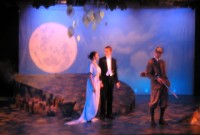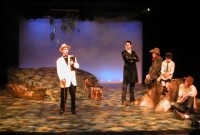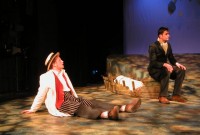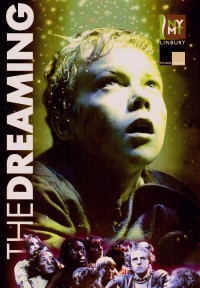the dreaming Miscellany
‘Gordon Winter’s intriguing book, A Country Camera 1844-1914, which was the source of much inspiration for the look of this production, finishes with the most moving photograph of a huge, horse-drawn cart carrying 16 or so young men. The caption reads, ‘The first men leaving Calne, Wiltshire, for the forces in August 1914’. These might have been the young men of Midsomer Magna (or any small West Country community where the dreaming is set), photographed a few weeks after the midsummer celebrations of June 1914.
The caption goes on to state: ‘They sat here for a minute or two in the sunshine to have their photograph taken; not much troubled about the future, knowing that what they were going to do was right, and anyway that it had to be done. We do not know how many of them – perhaps one should say how few of them – came back. We know only too well that the cream of their generation of countrymen died before they had time to reproduce themselves and to hand on their qualities to another age. But for those who did return, rural England had changed beyond recognition, and was never to be the same again.
The Dreaming was about to end.’
Jeremy James Taylor
“Never such innocence,
Never before or since,
As changed itself to past
Without a word – the men
Leaving the gardens tidy,
The thousands of marriages
Lasting a little while longer:
Never such innocence again”
Philip Larkin MCMXIV
the dreaming takes us back to a period when a belief in spiritualism was at its height. In 1917, two Yorkshire girls, Elsie Wright and Frances Griffiths even managed to fool Sir Arthur Conan Doyle creator of super sleuth Sherlock Holmes, into believing they had photographed fairies at the bottom of their garden.
Frances explained, “The first time I ever saw anything was when a willow leaf started shaking violently, even though there was no wind, I saw a small man standing on a branch, with the stem of the leaf in his hand, which he seemed to be shaking at something. He was dressed all in green….. They were real fairies. Some had wings and some not…. They were once sitting in a patch of sunlight on a low bank…. It all seemed so peaceful and friendly…. Sometimes they came up, only inches away, but I never wanted to join in their lives.”
The hoax wasn’t explained until 1982, when the pair finally admitted to photographing paper cut-outs supported by hat-pins. The Cottingley Fairies photographs fetched £6,000 at auction earlier this year, surely an indication that people still wish to believe in them.
the dreaming takes a fresh musical look at Shakespeare’s A Midsummer Night’s Dream, preserving the legacy of directors like Peter Brook, who persisted in exploring and adapting the protean structure of the play.
“I have come to the borders of sleep,
The unfathomable deep
Forestwhere all must lose
Their way, however straight,
Or winding, soon or late;
They cannot choose.”
Edward Thomas, Lights Out
“The return to the green chaos, the deep forest and refuge of the unconscious is a nightly phenomenon, and one that psychiatrists – and torturers – tell us is essential to the human mind.”
John Fowles, The Tree
“The darkness quakes with blood;
Form its pulse the dark eyes of the hunter glow
Green as their forest, fading images
Of the dream in the firelight: shudder of the coals
In their short Hell, vined skeleton
Of the charcoal-burner dozing in the snow.”
Randall Jarrall, The Märchen
“The vigil of St John comes on 23 June – his day is 24 June. On the evening of the 23rd, fires were lit, more for their smoke than for sparkling, crackling flames. The smoke was purifying. It strengthened the magic of plants already magical, it strengthened against the powers of evil all those who jumped across the fire. The herbs of St John were picked on the morning of 23rd before sunrise, when they were still wet with dew – itself a magical and strengthening substance”
Geoffrey Grigson, The Englishman’s Flora
“The legend of St George and the Dragon is imply an expression of the triumph of the Christian hero over evil, which St John the Divine beheld under the image of a dragon.
Brewer, Myth and Legend
“It is still believed inIrelandthat a ‘fiery bolt and dragon’ will, on a St John’s Eve that falls on a Friday, pass through the land…. Destroying in its path three-fourths of the people.”
Elenor Hull, Folklore of the British Isles
“They say that many years ago there was a wondrous flower… which was as rare as it was marvellous. It bloomed only on St John’s Night (some say under a fern) between the hours of eleven and twelve; but when the last stroke of twelve was struck, the flower vanished away… and no man every yet plucked it unless he had been set apart by Providence for the task. To him who was lucky enough to cull it, the flower revealed all the treasures of the earth….”
Lady Frazer, Leaves from the Golden Bough
Every village has its Jack, but no village every had quite so fine a Jack as ours:-
So picturesque,
Versatile,
Irresponsible,
Powerful,
Hedonistic,
And loveable a Jack as ours.
How Jack lived none knew, for he rarely did any work. True, he set night-lines for eels, and invariably caught one, Often two, Sometimes three; While very occasionally he had a day’s harvesting or haymaking. And yet he always found enough money for tobacco, With a little left over for beer, though he was no soaker”.
EV Lucas, Jack
“…..landscapes where the leaves have an animal fleshiness, and old pig-snouted Darkness grunts and roots in the hovels. There, the country gentlemen are rooted in the mould; and they know that beyond the sensual aspect of the sky (that harsh and goatish tent) something hides – but they have forgotten what it is.”
Essay by Edith Sitwell
“Many ancient sites were given the Devil’s name. That is because the Devil, with his… goat’s horns is, more often than not, just Pan, the King of the Faeries. Pan, like witchery, got a very bad press for being keen on fertility and the sacredness of the Earth.”
Evelyn Francis, Avebury
“…..the solar cult, of which Stonehenge and Avebury are the outstanding monuments, left also long-lasting memorials in human behaviour. On Midsummer Eve, large bonfires were constructed, and atmidnightthey were lit. It is said that not many centuries ago a dozen could be seen at a time, blazing in the villages, and round them were figures moving in rhythm, young men and garlanded girls, dancing and tossing violets and verbena into the flames…. Enough to say that this dying Festival of Fire persisted even into the last century, and still betrayed in its keeping….the worship of the sun…in many lands there were men and women bathing themselves and washing in the dew at the instant of sunrise…even the ‘Cloth’ had been known to foot it in honour of the sun…At Laughton in Yorkshire the Midsummer Fair was held in the churchyard. The church stands high on a hill, and the patron saint isSt John. It even became accepted that the fires were kindled in his honour.”
Laurence Whistler, The English Festivals
In that open field If you do not come too close,
If you do not come too close,
On a summermidnight, you can hear the music
Of the weak pipe and the little drum
And see them dancing around the bonfire
The association of man and woman In daunsinge, signifying matrimonie—
A dignified and commodiois sacrament.
Two and two, necessarye coniunction,
Holding eche other by the hand or the arm
Whiche betokeneth concorde.
Round and round the fire
Leaping through the flames, or joined in circles,
Rustically solemn or in rustic laughter Lifting heavy feet in clumsy shoes,
Earth feet, loam feet, lifted in country mirth
Mirth of those long since under earth Nourishing the corn.
Keeping time, Keeping the rhythm in their dancing
As in their living in the living seasons
The time of the seasons and the constellations
The time of milking and the time of harvest
The time of the coupling of man and woman And that of beasts.
Feet rising and falling. Eating and drinking. Dung and death.
TS Eliot, ‘East Coker’, from Four Quartets
“The lonelier the place, the better it pleased me: its silence, its aura, its peculiar confirmation, its enclosedness. I had a dream of some endless combe, I suppose almost an animal dream, an otter-dream, of endless hanging beechwoods and hazel coppices and leated meadows, houseless and manless…”
John Fowles, The Tree
“And the countryside not caring:
The place-names all hazed over
With flowering grasses, and fields
Shadowing Domesday lines
Under wheat’s restless silence;
The differently-dressed servants
With tiny rooms in huge houses,
The dust behind limousines.”
Philip Larkin, MCMXIV
What have I done for you, England, my England?
What is there I would not do England, my own?
With your glorious eyes austere,
As the Lord were walking near,
Whispering terrible things and dear
As the Song in your bugles blown, England-
Round the world on your bugles blown!
Ever the faith endures, England, my England:-
‘Take and break us: we are yours, England, my own!
Life is good, and joy runs high
Between English earth and sky:
Death is death; but we shall die
To the Song on our bugles blown,
England- To the stars on your bugles blown!”
William Ernest Henley, For England’s Sake; Verses and Songs in Time of War (1891)
“Into my heart an air that kills
From yon far country blows:
What are those blue remembered hills,
What spires, what farms are those?
That is the land of lost content,
I see it shining plain,
The happy highways where I went
And cannot come again.”
AE Houseman, A Shropshire Lad
“…And while I stood gazing, both the children gradually grew fainter to my view, receding, and still receding till nothing at last but two mournful features were seen in the uttermost distance, which, without speech, strangely impressed upon me the effects of speech: ‘We are not of Alice, nor of thee, nor are we children at all…We are nothing: less than nothing, and dreams. We are only what might have been…”
Charles Lamb, Dream Children, a Reverie
She still haunts me, phantomwise,
Alicemoving under skies
Never seen by waking eyes.
Children yet, the tale to hear, Eager eye and willing ear,
Lovingly shall nestle near.
In Wonderland they lie,
Dreaming as the days go by,
Dreaming as the summers die:
Ever drifting down the stream –
Lingering in the golden gleam –
Life, what is it but a dream?
Epilogue to Through the Looking-Glass, Lewis Carroll
This must be the wood,” she said thoughtfully to herself, “where things have no names. I wonder what’ll become of my name when I go in? I shouldn’t like to lose it at all …”
Looking-glass Insects, Lewis Carroll
“Across the world people are flocking to ancient temples. Why? Perhaps it is because they do something to us… Maybe one day a new science will begin and maybe then we will better understand the ancients.”
Evelyn Francis, Avebury
“There are freedoms in woods that our ancestors perhaps realised more fully than we do.”
John Fowles, The Tree
“Our life is no dream, but it should be and will perhaps become one.”
Novalis



